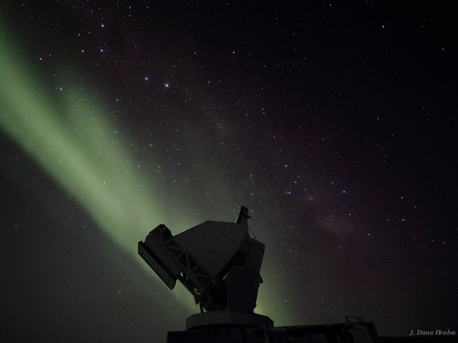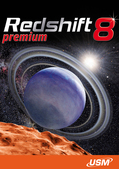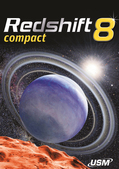Space Weather
Southern Polar Lights
The solar eruption of August 7th might affect Earth after all. Newly-arriving data from the Solar and Heliospheric Observatory (SOHO) show a CME heading our way with a significant Earth-directed component.
 |
Southern Polar Light in Antarctica
The impact of this lopsided CME probably won't trigger a major geomagnetic storm---but the SOHO data show it could be bigger than expected. High latitude sky watchers should be alert for auroras when the cloud arrives probably on August 10th.
The stage is set for a good display of auroras over Antarctica. The skies are already shimmering even before the CME arrives.
J. Dana Hrubes is wintering over at the Amundsen-Scott Station where he oversees operations of the South Pole Telescope (SPoT), silhouetted above by aurora australis. "After one of the windiest Julys on record, we finally got some very clear skies on August 9th," he says. "The auroras were a welcome surprise. The sun will be returning to the South Pole in a little over 6 weeks, so I'm hoping for more auroras soon."
He may get them. NOAA forecasters estimate a 30% chance of polar geomagnetic activity when the incoming CME arrives. Stay tuned for Southern Lights!
source: Space Weather.com
The stage is set for a good display of auroras over Antarctica. The skies are already shimmering even before the CME arrives.
J. Dana Hrubes is wintering over at the Amundsen-Scott Station where he oversees operations of the South Pole Telescope (SPoT), silhouetted above by aurora australis. "After one of the windiest Julys on record, we finally got some very clear skies on August 9th," he says. "The auroras were a welcome surprise. The sun will be returning to the South Pole in a little over 6 weeks, so I'm hoping for more auroras soon."
He may get them. NOAA forecasters estimate a 30% chance of polar geomagnetic activity when the incoming CME arrives. Stay tuned for Southern Lights!
source: Space Weather.com
Space Weather
Southern Polar Lights
The solar eruption of August 7th might affect Earth after all. Newly-arriving data from the Solar and Heliospheric Observatory (SOHO) show a CME heading our way with a significant Earth-directed component.
 |
Southern Polar Light in Antarctica
The impact of this lopsided CME probably won't trigger a major geomagnetic storm---but the SOHO data show it could be bigger than expected. High latitude sky watchers should be alert for auroras when the cloud arrives probably on August 10th.
The stage is set for a good display of auroras over Antarctica. The skies are already shimmering even before the CME arrives.
J. Dana Hrubes is wintering over at the Amundsen-Scott Station where he oversees operations of the South Pole Telescope (SPoT), silhouetted above by aurora australis. "After one of the windiest Julys on record, we finally got some very clear skies on August 9th," he says. "The auroras were a welcome surprise. The sun will be returning to the South Pole in a little over 6 weeks, so I'm hoping for more auroras soon."
He may get them. NOAA forecasters estimate a 30% chance of polar geomagnetic activity when the incoming CME arrives. Stay tuned for Southern Lights!
source: Space Weather.com
The stage is set for a good display of auroras over Antarctica. The skies are already shimmering even before the CME arrives.
J. Dana Hrubes is wintering over at the Amundsen-Scott Station where he oversees operations of the South Pole Telescope (SPoT), silhouetted above by aurora australis. "After one of the windiest Julys on record, we finally got some very clear skies on August 9th," he says. "The auroras were a welcome surprise. The sun will be returning to the South Pole in a little over 6 weeks, so I'm hoping for more auroras soon."
He may get them. NOAA forecasters estimate a 30% chance of polar geomagnetic activity when the incoming CME arrives. Stay tuned for Southern Lights!
source: Space Weather.com








